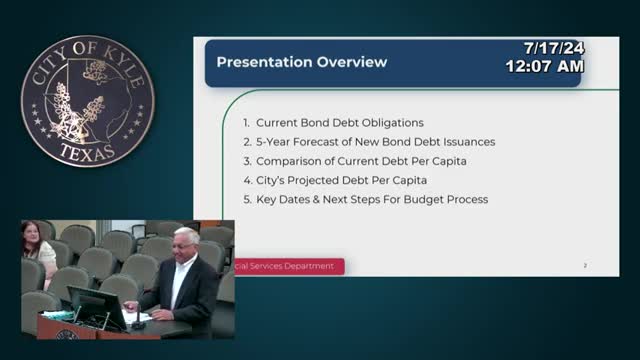City faces staggering debt projections over next five years
July 17, 2024 | Kyle City, Hays County, Texas

This article was created by AI summarizing key points discussed. AI makes mistakes, so for full details and context, please refer to the video of the full meeting. Please report any errors so we can fix them. Report an error »

During a recent government meeting, officials provided a detailed overview of the city's current debt obligations and a five-year financial forecast. The current debt obligation stands at approximately $159.7 million, with an anticipated total repayment of $236.8 million, including $77 million in interest. This fiscal year, the city is set to pay $8.9 million in principal and $8 million in interest, totaling $17 million in debt service payments.
The discussion highlighted the city's property tax rates, which consist of maintenance and operation, and interest and sinking rates. The current property tax rate is set at 4.693%. A comparative analysis of debt per capita revealed that Kyle's debt per capita is $27,100, placing it third among ten peer cities. The city’s net debt per capita, which accounts only for debt supported by property tax, is significantly lower at 2.5%, indicating a favorable position compared to Pflugerville and Buda, which have higher ratios.
Officials emphasized the importance of debt as a percentage of assessed valuation, a key metric for bondholders and rating agencies. The lower the percentage, the better the perceived ability to repay debt. The city’s financial adviser noted that Kyle's debt-to-assessed valuation ratio has improved since 2016, when it was among the highest due to significant bond issuances for infrastructure projects.
Looking ahead, the city anticipates issuing approximately $607 million in new debt over the next five years, with $374 million supported by property taxes. This includes funding for various infrastructure projects such as road improvements and park developments. The forecast suggests that by 2029, the debt per capita could rise to over $8,000, contingent on the city's financial strategies and market conditions.
Overall, the meeting underscored the city's proactive approach to managing its debt while planning for future growth and infrastructure needs.
The discussion highlighted the city's property tax rates, which consist of maintenance and operation, and interest and sinking rates. The current property tax rate is set at 4.693%. A comparative analysis of debt per capita revealed that Kyle's debt per capita is $27,100, placing it third among ten peer cities. The city’s net debt per capita, which accounts only for debt supported by property tax, is significantly lower at 2.5%, indicating a favorable position compared to Pflugerville and Buda, which have higher ratios.
Officials emphasized the importance of debt as a percentage of assessed valuation, a key metric for bondholders and rating agencies. The lower the percentage, the better the perceived ability to repay debt. The city’s financial adviser noted that Kyle's debt-to-assessed valuation ratio has improved since 2016, when it was among the highest due to significant bond issuances for infrastructure projects.
Looking ahead, the city anticipates issuing approximately $607 million in new debt over the next five years, with $374 million supported by property taxes. This includes funding for various infrastructure projects such as road improvements and park developments. The forecast suggests that by 2029, the debt per capita could rise to over $8,000, contingent on the city's financial strategies and market conditions.
Overall, the meeting underscored the city's proactive approach to managing its debt while planning for future growth and infrastructure needs.
View full meeting
This article is based on a recent meeting—watch the full video and explore the complete transcript for deeper insights into the discussion.
View full meeting
